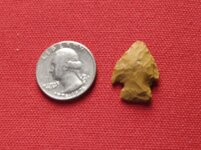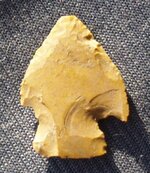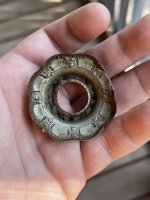tomsneck
Sr. Member
 This has to be one of my coolest points. I found it today at the end of a long unproductive beach walk. Only found a few flakes, so I decided to head for the truck. We walked back not by the beach but a long driveway and in a spot where someone had done some brush cutting last year and cut too low, this was perched on a little pedestle of dirt. Almost mistook it for a leaf. It's missing the very tip and one wing, also it's almost perfectly flat on the back side. never seen the like here. Thanks for the look
This has to be one of my coolest points. I found it today at the end of a long unproductive beach walk. Only found a few flakes, so I decided to head for the truck. We walked back not by the beach but a long driveway and in a spot where someone had done some brush cutting last year and cut too low, this was perched on a little pedestle of dirt. Almost mistook it for a leaf. It's missing the very tip and one wing, also it's almost perfectly flat on the back side. never seen the like here. Thanks for the lookcolin
Attachments
Upvote
0






